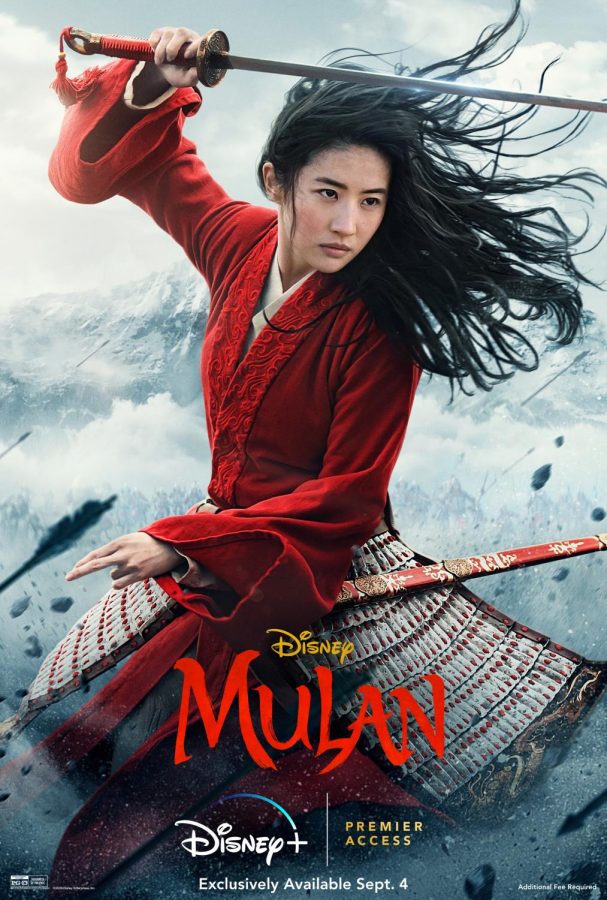Review: Mulan (2020)
September 17, 2020

3.5/5
From a Chinese folktale centuries ago to a Disney animated film in 1998, the age-old legend of Mulan is one that is familiar, inspiring and relevant. Now that the live-action adaptation is finally in theaters (and computer screens), Disney faces high expectations to once again tell a story that resonates with viewers all over the world.
Even before its release, the 2020 Mulan was criticized for its numerous unpopular changes from the animated version. In director Niki Caro’s live-action version, there are no emotional songs, no clumsy dragon sidekick, and no General Shang (who is one of the most beloved Disney princes despite not really being a prince). In their place are entirely new elements like a nameless phoenix, a shapeshifting sorcerer, and a lot more focus on Mulan’s personal life outside of saving China.
Many of these changes are not terribly surprising when compared to other live-action adaptations of classic Disney movies. In its 2015 Cinderella adaptation, Disney also altered the plot to be more realistic, removing the musical numbers and offering a lot more backstory for the stepmother’s jealousy. In 2020’s Mulan, the reasons behind changing certain elements are similarly easy to see. Mushu’s absence, as lovable as he is, allows Mulan to have the serious, steely attitude that she needs in order to survive. The diminished role of the love-interest, Honghui, helps to emphasize even more than in the animation that the “knight in shining armor” trope is outdated and unnecessary.
And the sorcerer antagonist Xianniang, by far the most controversial of the added characters, is certainly not just a cheap makeover of the original Shan Yu’s pet hawk. Xianniang is conspicuously and unapologetically feminist, which was a daring move for Caro to pull in a still male-dominated industry, but her character plays an important role in sending the message that navigating a world of gender constraints is not a smooth, uncomplicated path. Not only does her alienation from the male antagonists (even as she is the source of their strength) serve as a warning to Mulan about the patriarchy’s inability to accept female power, her love-hate relationship with Mulan throughout the film reveals the emotional turbulence that comes with defying the world’s standards. Xianniang’s existence, however unexpected at first, eventually adds a maturity to Mulan’s story that we didn’t get to see in the original animation.
Another more subtle but equally significant difference from the animated film is the added focus on the Chinese warriors’ virtues of loyalty (zhōng), bravery (yǒng) and truth (zhēn). While Mulan’s courage and loyalty are both apparent from the start, being the very reasons why she leaves to fight in her father’s stead, Mulan’s journey to discovering what “truth” really means to her is difficult and sends a compelling message. 1998’s Mulan does touch upon Mulan’s inner struggles (which is how one of the most popular Disney songs “Reflection” came to be), but most of the movie is not about those struggles, with Mulan’s efforts mostly spent on getting other people to accept her. In 2020’s Mulan, however, Mulan’s self-acceptance is the key turning point in her success as a warrior. Without overcoming her own shame and embracing who she is, Mulan would not have unlocked her full potential and may not have saved China at all.
We get to see much more of her father’s struggles with truth here too, as he first puts on a mask of disapproval to protect Mulan from the judgement of society before realizing the power of her true identity. Perhaps this is why the live-action movie is told through the narration of Mulan’s father—like most of us, he is afraid to challenge the expectations of the world, and like most of us, he is inspired to do that by Mulan’s touching story.
For me, the thought that was put into these changes are a testament that the live-action Mulan is not the shameless cash grab many Disney adaptations unfortunately tend to be. Like many other fans of the original Mulan, I admittedly was disappointed to not see iconic scenes like Mulan cutting her hair, and to have to deal with new characters almost completely unrelated to the animation. But I would much rather have this version of Mulan be the refreshing update that it is than a conservative, unexceptional remake of something we’ve all seen before.

While the changes Caro made to the live-action Mulan are justified and valuable, however, the movie fails to meet expectations for another important aspect. In terms of historical accuracy, the live-action film appallingly falls short.
Growing up Chinese and listening to my family in China recount the legend, I learned that the story of Mulan is one that is beautiful in its simplicity. The real Hua Mulan was a village girl who never rejected her femininity but wanted to protect her father and inadvertently proved that men and women can accomplish the same things. She wasn’t a savior or an outcast or a “chosen one.” Any young woman could have done what she did, and that is what makes her story so inspiring.
The animated film in 1998 of course doesn’t show this story accurately, which is why I and many others were thrilled when the live-action Mulan promised to be much more faithful to the actual folktale. But the movie I watched did not capture the real Hua Mulan in any capacity. The movie’s Mulan is blessed with the powers of the Earth (“chi”) and stands out from the rest of her village from the very beginning. These traits make her almost a superhero, but they also make her a bad role model. Instead of showing that any regular person can fight against gender norms, Mulan and her special powers carelessly reinforce the stereotype that women cannot actually be on the same level as men without some outside force aiding them. This indulgence of toxic mainstream ideas severely undermines both the empowering message of the original folktale and the progressive nature of the movie itself.
To be honest, I never really expected Disney to follow through on their promise in the first place, considering that the 1998 Mulan film had already cemented her as a Disney “princess.” In typical Disney princess fashion, she had to be especially extraordinary. It’s a bit harder for little kids to look up to a regular village girl than a glamorous, almost-magical warrior, after all. It was disappointing, nonetheless, to see a treasured part of Chinese history misrepresented again in Western media.
Still, the messages in the film are not invalidated because of these differences. The movie’s experienced cast of Asian actors, elaborate martial arts choreographies, and detailed incorporations of Chinese traditions make it clear that Disney hasn’t forgotten the story’s origins. Complete with easter eggs referencing the original Ballad of Mulan and a cameo from the 1998 movie voice actor Ming-Na Wen, the film more than fulfills my childhood nostalgia from the first Chinese Disney princess.
There is certainly much more to unpack in the 2020 Mulan than any Disney princess movie, live-action or animated. Caro’s version goes beyond the bare bones of Mulan’s story to try and tackle much more realistic perspectives about feminism. The original, iconic themes of equality and strength are still there, but the live-action Mulan also offers equally important messages about self-discovery and painful endurance.
Its problems, controversies and disappointments are in many ways natural for a bold retelling of a story that’s been adapted so many times before. And despite not being completely loyal to the original folktale, the movie is brave in its gutsy choices and true to its powerful messages. As it has done so many times before, Mulan’s story demonstrates the positive impact of rejecting whatever limits the world places on women.
Disney’s live-action Mulan is ultimately a beautiful reminder that even after many centuries, the legacy of Hua Mulan is relevant and alive.



